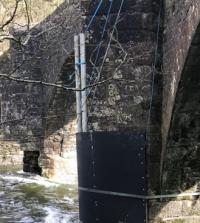A high-profile fracture of a truss end in late 2015 had led to the closure of the bridge for three weeks while emergency repairs were carried out.
Amey had carried out emergency works to make the bridge safe to re-open, then to replace the existing truss ends on the north-east span with a new sliding bearing as part of a trail operation (link opens in new tab). Spencer was then appointed to carry out similar works on the remaining seven truss ends on the rest of the bridge.
The company is tasked with cutting out the obsolete sections and replacing them with a sliding bearing system. It has begun the off-site fabrication works necessary to begin the major on-site refurbishment works, which have now also started.
Spencer Group civil engineering project manager James Barnes said: “The work will involve conducting complex engineering works, high above the water. It’s a huge technical challenge manoeuvring sections of bridge weighing up to 16 tonnes into position under the bridge deck. Our top priority is creating a safe and workable solution that ensures as little disruption to the general public as possible.”
Spencer was appointed to complete the process of replacing the old truss end links with sliding bearing system following the discovery of a crack in the north east main span link that connects the tower to the road deck. This includes removing the temporary solutions on the main deck and installing the bearings, as well as installing both temporary solutions and the new bearings on the side decks.
The truss end link replacements require a series of complex works to be delivered to a part of the Forth Road Bridge that has limited accessibility. The tower cells adjacent to the location of the replacement works require strengthening to take the combined 14 tonne weight of the support bracket and new sliding bearings, which need to be barged out and hoisted up into their final position.
As part of the works, Spencer will also install modifications that will make future works on the bearings considerably easier. This includes installation of new access stairs and permanent access platforms to allow easy maintenance all year round, without the need to erect temporary steelwork.



